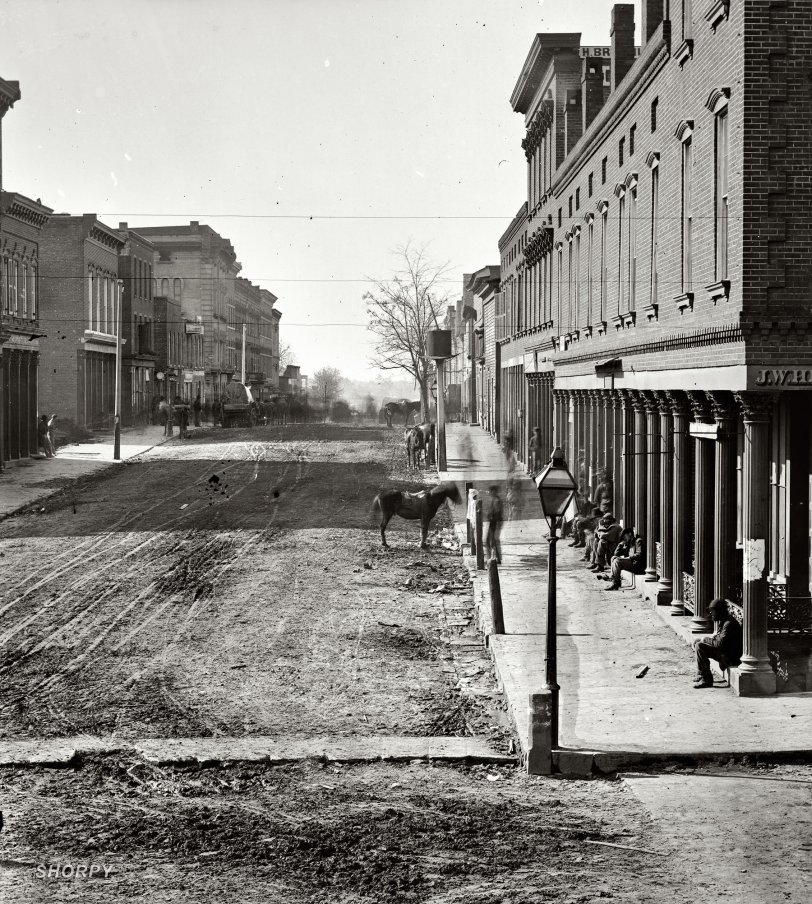


Framed or unframed, desk size to sofa size, printed by us in Arizona and Alabama since 2007. Explore now.
Shorpy is funded by you. Patreon contributors get an ad-free experience.
Learn more.

- Baldwin 62303
- Baldwin VO-1000
- Cold
- No expense spared
- Tough Guys
- Lost in Toyland
- And without gloves
- If I were a blindfolded time traveler
- Smoke Consumer Also Cooks
- Oh that stove!
- Possibly still there?
- What?!?
- $100 Reward
- Freeze Frame
- Texas Flyer wanted
- Just a Year Too Soon
- WWII -- Replacing men with women at the railroad crossing.
- Yes, Icing
- You kids drive me nuts!
- NOT An Easy Job
- I wonder
- Just add window boxes
- Icing Platform?
- Indiana Harbor Belt abides
- Freezing haze
- Corrections (for those who care)
- C&NW at Nelson
- Fallen Flags
- A dangerous job made worse
- Water Stop
Print Emporium
Hatlanta: 1864

1864. "Atlanta, Georgia. Street view." To the right, a hatter. Everywhere else, dirt and mud. Wet plate glass negative by George N. Barnard. View full size.
All a blur
I love the effect of the time exposure. You can actually see the street activity from 1864. Very cool.
The Smell
They had to be used to it. What other conditions did they know of? I too think about this often. Especially the women in all that clothing in that heat. Oh My! There's no way modern people could survive. The smells alone would surely take us out!
This is Whitehall Street
If you are familiar with the other famous Barnard photograph showing the building marked "Negro Sales" this is what you would see if you stood beside that building and turned to face the opposite direction.
Early crosswalk
I liked the apparent "crosswalk" in the foreground, it looks like a series of paving blocks crossing the otherwise muddy street. However, with one block missing and several others being overtaken by the mud, it may have been an idea before its time.
I'd rather look at it than smell it!
I can never study scenes from this and later periods without thinking what it would be like for a 21st century American to be dropped into this 1864 Atlanta on a summer day - the assault on modern-day olfactory senses would be an experience that would be hard to get used to. Dirt, refuse, horses, tobacco use, coal and wood smoke, cooking odors, lack of refrigeration, no public refuse services, industrial effluence, inadequate drainage and sewerage facilities; laundering and cleaning a labor-intensive effort; bathing not a daily luxury or possibility (or desire) for most people. Those for whom city living was the norm may have hardly noticed. Country living may have been marginally better - if you were outdoors. Even in Washington DC at this time, pigs and chickens were in the streets. Such conditions took a toll on life expectancy.
Wired
Are those wires running across the street, or scratches on the negative?
[Actual wires, visible in another photo taken from the same spot. Telegraph wires I guess. - Dave]
Period Candids
Thank goodness for idlers, otherwise we'd never have truly candid images of people from this period. Also, one of the best-ever Shorpy ghosts, leaning against the lamppost in the right foreground.
Veryy Punny!
Nice play on Atlanta's other nickname. How on earth can you tell there's a hatter there, though? I can't make out any clue...
Boot seller
There's a boot store across the street from the haberdasher and about 2 buildings up. Good thing too with all that dirt and mud!
There is also a boot, which
There is also a boot, which I would take as a shoe store and a horse head which would indicate a harness and saddlery shop
3-D store signs
I see several three-dimensional store signs on this street: the hat, what appears to be a boot on the left, and a horse's head. Any thoughts on whether these were aids to help identify the store in the days of prevalent illiteracy, or just a local fad?
























On Shorpy:
Today’s Top 5